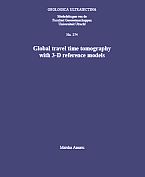
Global travel time tomography with 3-D reference models / Maisha Lara Amaru - [S.l.] : [s.n.], 2007 - Doctoral thesis Utrecht University

 |
Global travel time tomography with 3-D reference models Global travel time tomography with 3-D reference models / Maisha Lara Amaru - [S.l.] : [s.n.], 2007 - Doctoral thesis Utrecht University |
In this study, a global high-resolution P-wave velocity model is obtained for the Earth's crust and mantle using travel time tomography. Improvements to previous models are achieved by incorporating additional data and advancing the method to use 3-D reference models. The newly compiled data set consists of a selection of travel times from the updated EHB catalog (Engdahl et al., 1998), which forms a subset of 445,000 events from the ISC bulletins and NEIC data up to September 2004. The data selection contains 17.7 million first and later-arriving P phases and additionally 1.5 million core phases. The data set is extended by 14,000 events from the EMSC bulletins for the period 1998-2003. Furthermore, over 200,000 newly picked, high-accuracy arrival times are incorporated originating from recordings of seismic networks and temporary experiments in Europe and North America which did not report arrival times to the ISC. Methodologically, instead of a standard 1-D Earth reference model, 3-D reference models are used for the tomographic inversion based on a combination of tomography models that use travel time residuals and models that use independent observations from surface waves, normal modes and long period body waves. In addition, the selected events are relocated in the respective 3-D reference model prior to tomography using a directed grid-search technique to establish consistency between travel times and earthquake parameters. The impact of the new regional data contained in the EHB catalog is investigated in a regional Pn tomography study of the crust and uppermost mantle beneath Europe. This analysis shows that for P velocities in the crust and uppermost mantle anomalies of a lateral extent of 0.4 degrees can be resolved and for S velocities anomalies of 0.8 degrees providing detailed images of the crust and uppermost mantle structure. Due to the newly picked data, more detail is seen in the upper 400 km, particularly in regions with few seismic stations and/or earthquakes. For instance, the mantle beneath western North America is imaged in high resolution comparable to regional tomographic studies and due to the new data set the remnants of the Farallon plate, an ancient oceanic plate, can be located in the upper mantle transition zone. Furthermore, features that were already observed earlier are enhanced. Besides that, the core phases help to constrain anomalies in the lowermost mantle and greatly improve, for example, imaging of the hot upwelling beneath Central Europe. Due to the use of 3-D reference models, the resulting model combines the long wavelength structure as seen by long period seismic information with the detailed mantle structure obtained from short period data. As an application of the new high-resolution tomography model, tests with well-located events demonstrate that the new model predicts, particularly at regional distances, arrival times better than a 1-D velocity model, and that epicenter mislocations and origin time errors are reduced using the new model. keywords: travel times, seismic tomography, velocity model, reference model, mantle structure, earthquake location |